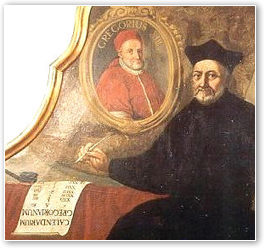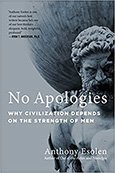The Reckoning of the Times
- ANTHONY ESOLEN
The revelers in Times Square on New Year's Eve had a pope to thank, if they only knew it.
Join the worldwide Magnificat family by subscribing now: Your prayer life will never be the same!
 Father Christopher Clavius, S.J.
Father Christopher Clavius, S.J.1538-1612
By the time you turn this page, gentle reader, millions of people will have gathered in Times Square as usual to watch the great Secular Odometer turn from 99999 to 100000, as the new year begins, very like the old year, progressing on in the secular imagination toward some longed-for oasis of earthly delights, between the deserts of nothing before and nothing to come. Little do the feasters know that, were it not for Pope Gregory XIII, they would have arrived two weeks too late.
The Church teaches us that time springs from and returns to its origin in the providence of God the Creator. Or we might say that time is the rich soil wherein the wheat is sown for the harvest; or it is the arena for the heroic story of man's salvation, with its fixed center in Calvary, where Christ triumphant pierces the heart of hell with the cross. Or it is the meter of the epic of faith, as we fight the good fight or run the race to the finish. So the Church does not brush time aside. She sanctifies time and elevates it, giving us far more yearly feasts to celebrate than modern man, always a-bustle and always late, knows what to do with.
But she has also always wanted to get the time right. And here we run into difficulties.
When a baby boy was born to Augustine and Mary Washington on the shores of the Potomac River, they recorded his birthday as February 11,1731. Many of us are familiar with the phenomenon of "losing" an hour or two as we travel by air from west to east, but that was nothing like what George Washington lost. For he was later to affirm, correctly, that he was born on February 22, 1732, giving Americans the date for the celebration of his birthday, and prompting the striking of the Washington quarter dollar in 1932, the year of its bicentennial.
What happened? Were his parents so far behind the times? It's one thing to be off by a day or two. But eleven? And a whole year?
A small error in the beginning
We turn then to Rome. The year is 1580, and a tireless old bulldog of a man, Gregory XIII, has succeeded Pope Saint Pius V to the Chair of Peter. Gregory founded or expanded about three hundred schools and universities. He appointed men like Saint Charles Borromeo to undertake a thorough reform of Catholic seminaries. He sent missionaries to all parts of the world, receiving emissaries from Japan to thank him for sowing the Faith there. He founded the English College in Douai, France, for the education of priests who then returned to their native land to celebrate Mass in hiding and confer the sacraments, until such time as the priest-hunters of Queen Elizabeth should seize them and subject them to torture and a gruesome and protracted execution. It is said that Gregory sang the Te Deum when he heard about the Saint Bartholomew's Day massacre of Protestant Huguenots in Paris, but there was no Internet in those days, and all that the pope knew of it was that a political revolt against a legitimate ruler had been put down. He wept when he learned at last what had really happened.
The times were also quite literally out of joint. If you ask a hundred people what a year is, you might get half of them to say that it is the time it takes for the earth to make one complete revolution about the sun. The next question is obvious. "How do you know when the earth has done that?"
"Well, you look at the calendar."
"And where did the calendar come from? If you didn't have a calendar, how would you know?"
Silence falls, and crickets chirp from the woods.
The sun has two apparent motions about the earth. The one is its daily journey from east to west. It is especially long in the summertime, when Mister Apollo the charioteer sweats at high noon, and his steeds long for their watering hole at the border of night.
The other movement is attributable to the tilt of the earth, of about twenty-three degrees. The tilt makes it so that the sun's path changes from day to day as the rotating earth moves in its yearly course. In England and North America, the sun rises higher and higher in its meridian as the days grow longer, until at one point it seems to "stop" — hence we have the word solstice, sun-stop. Then its noon is lower and lower in the sky, until at another point it stops again. We can measure our years according to the regular patterns of that path.
The problem is that the year is a little longer than 365 days. Julius Caesar tried to account for that by putting in "leap year" days for every fourth year, but that turned out to be a little too many. People began to notice it. Dante, in the Middle Ages, was well aware that the calendar had been lagging. Eventually, Beatrice says, the "neglected hundredths of your years" would cause spring to begin in January!
Not to worry, old ladies tending your flower gardens: that did not mean that snow would kill your daffodils, no more than Daylight Savings Time would fade your curtains. Days would be days and years would be years, but your computation would be off.
The keys to the calendar
So Gregory summoned one of his advisors, a German priest named Christopher Clavius (Christoph Klau), called the "Euclid of the 16th century." Clavius was that sort of Renaissance man who was really most prominent in the Middle Ages: bom and raised in Bavaria, professor in Portugal, and papal mathematician and astronomer in Rome. Tycho Brahe and Johannes Kepler esteemed him highly, and he was a lifelong friend of Galileo. His voluminous works were translated into various languages; that included Chinese, so that his fellow Jesuits, such as his student Matteo Ricci, the great missionary to China, could take them to that land of clockmakers and stargazers and seekers of the Order of Heaven.
The most obvious need was to get rid of the ten "extra" days that had intruded. But Gregory and Clavius wanted more than calendrical duct tape. They wanted a solution that would, for all practical purposes, settle matters once and for all. That required excruciatingly precise astronomical observation and measurement and computation. What Clavius came up with was perfect, and was implemented in Catholic nations by papal decree in 1582.
That year, if your birthday fell between October 5 and 14 inclusive, well, you might as well have been born on February 30, because those ten dates for that year were cut out. But the problem would have arisen again, had not Clavius hit upon the notion of omitting leap year days for three out of four century years. So we had a February 29 in 2000, divisible by 400, but there was none in 1900, and there will not be another one in a century year until 2400. That will keep our calendars in trim for the next thirty thousand years, if the Lord does not wind things up here sooner, as we hope he will.
Had Christendom not been divided, little George Washington would have been born on February 22 and not February 11 (you see, an eleventh extra day had wriggled in already). But for a long time the Protestant nations resisted adopting a "Catholic" calendar. That finally changed for England and her colonies, in 1752 — another year of vanishing dates — and now the Gregorian calendar is pretty much universal.
The true New Year
"But wait a moment," you say. "That explains the dates in February, but it doesn't explain the year."
Quite correct. You see, the convention of setting the beginning of the New Year as January 1 derives from Julius Caesar himself, but it wasn't the only candidate. Christians in England, for example, before the Norman Conquest in 1066 and then between 1155 and 1752, reckoned the New Year as beginning on March 25, the feast of the Annunciation. Other Christian countries counted Christmas, December 25, as beginning the new year. And why not?
For on that day when the angel appeared unto Mary, the Word was made flesh, and dwelt among us; and on that day nine months later we first beheld his glory, as he lay wrapped in swaddling clothes and lying in a manger.
And so the revelers in Times Square have a pope to thank, if they only knew it.
 This is Meaghen Gonzalez, Editor of CERC. I hope you appreciated this piece. We curate these articles especially for believers like you.
This is Meaghen Gonzalez, Editor of CERC. I hope you appreciated this piece. We curate these articles especially for believers like you.
Please show your appreciation by making a $3 donation. CERC is entirely reader supported.

Acknowledgement
 Anthony Esolen. "The Reckoning of the Times." Magnificat (January, 2016): 199-203.
Anthony Esolen. "The Reckoning of the Times." Magnificat (January, 2016): 199-203.
Join the worldwide Magnificat family by subscribing now: Your prayer life will never be the same!
To read Professor Esolen's work each month in Magnificat, along with daily Mass texts, other fine essays, art commentaries, meditations, and daily prayers inspired by the Liturgy of the Hours, visit www.magnificat.com to subscribe or to request a complimentary copy.
The Author

Anthony Esolen is writer-in-residence at Magdalen College of the Liberal Arts and serves on the Catholic Resource Education Center's advisory board. His newest book is "No Apologies: Why Civilization Depends on the Strength of Men." You can read his new Substack magazine at Word and Song, which in addition to free content will have podcasts and poetry readings for subscribers.
Copyright © 2016 Magnificat



